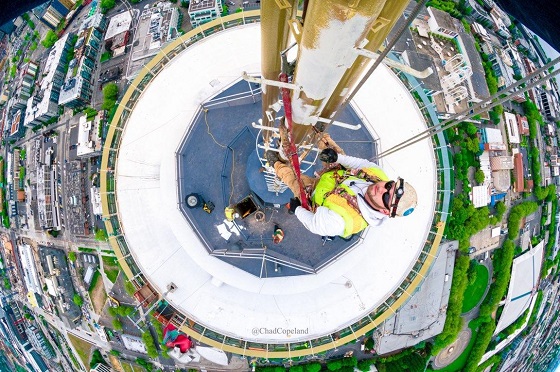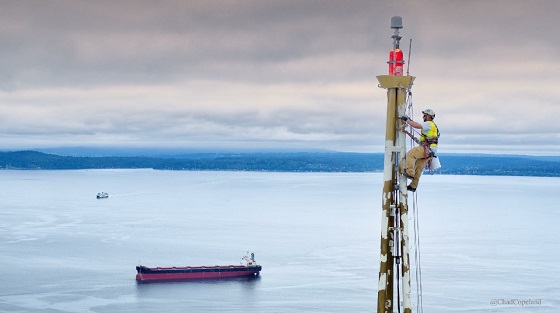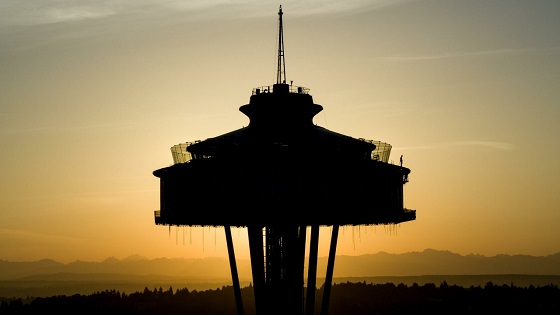The iconic Space Needle is an observation tower in Seattle, Wash. At 605 feet (184.4 m) tall and with an observation deck 520 feet (158.5 m) above the ground, it was built for the 1962 World’s Fair and was, at one point, the tallest structure west of the Mississippi River. As one of the Pacific Northwest’s most popular structures, it is now designated as a historic landmark. The observation deck includes a revolving restaurant, where hundreds of daily visitors can enjoy 360-degree views of Seattle and the Puget Sound.
But after nearly 60 years of operation, it was time for an extensive renovation to keep the Space Needle in peak form for decades to come. The privately funded project, designed to preserve and update the structure’s physical systems and visitor experience, featured a number of upgrades from various contractors, including new protective coatings to the exterior, interior, and deck. The coatings were selected to match a previous job from more than 20 years ago, since Seattleites understandably wanted to preserve the structure’s usual look.
Based in nearby Tukwila, Purcell Painting & Coatings was a natural fit as the coatings contractor, since they were acutely aware of all the unique considerations that come with coating in the notoriously wet and windy climate of the Seattle area. The coatings portion of the job took place throughout 2018 and 2019, which fortunately allowed the crew to wrap up their work before any additional COVID-19 precautions were necessary.
Scaling the Tower
Perhaps the biggest challenge involving the Space Needle job was access, owing to the structure’s complex geometry. “The legs bend in and then go out,” explained Dave Purcell Sr., president and owner of the contracting company. “This required pulling the staging and man buckets in an angle to reach them.” Spider lifts proved to be an optimal solution.
“The legs are shaped like an hourglass, so you had to pull yourself in on the legs, while the elevators were operational,” Purcell recalled. The crews did all they could, including working at odd hours, to avoid disruptions. In all, Purcell averaged between 8 and 24 crew members at the site, depending on the phase.

Another unique access requirement involved coating in and around the “halo” structure atop the Space Needle. “We had to walk the halo and use man spiders to go around the halo,” Purcell said. “There was a platform installed underneath the top, and a scaffolding QuikDeck installed underneath that.” The custom-made BrandSafway suspended platform ring had three sections, each at about 16-feet (4.9 m) wide and connected with 8-foot (2.4 m) walkways. The platform was able to withstand winds of more than 100 mph (160.9 km/hr.) and resulted in significant cost savings, relative to the use of traditional scaffolding and a large crane. These savings were especially important, since the project was privately funded.
Needle in a Haystack
For the Seattle Space Needle, all of the tower’s exterior and interior surfaces were to be coated. These substrates included both structural steel and decking. Yet, even with a project of such a large scope, they had to work very slowly and methodically, given the surrounding area.
“The world-famous Chihuly Glass Garden sits directly below the Space Needle,” Purcell recalled. “Keeping falling items and overspray off of it was a challenge.” As a result, coating on the exterior was primarily done utilizing brushes and rollers. But even when using hand tools, crew members still had to be extremely delicate in their work.
“We had to move slowly to keep any brush drips from going into the atmosphere,” Purcell said. “We had to go at probably half the speed we typically would. That glass garden is worth millions and millions of dollars. We actually did get a little bit on one small part, which required professional cleaning. Fortunately, we were able to keep it to a very minimum and didn’t [clean] the whole thing, which would’ve put me out of business!” Full containment wasn’t a realistic option, Purcell explained, because it likely would have tripled the overall project cost.

It did help that Purcell’s crews were trained and certified to meet the Society for Protective Coatings (SSPC) Qualification Procedures (QP) 1, QP2, and QS1 standards for quality. Throughout the project, crew members also utilized important pieces of personal protective equipment (PPE), such as gloves, hard hats, high-visibility vests, work boots, and fall protection gear.
The exterior portion of the Space Needle job was an overcoat project, utilizing a moisture-cured urethane system from local manufacturer Wasser Coatings. Surface preparation consisted of pressure washing to help achieve the SSPC Surface Preparation (SP) 2, “Hand Tool Cleaning,” and SSPC-SP 3, “Power Tool Cleaning” standards, and various areas were “spot primed” with Wasser’s MC-Miozinc 100 and MC-Universal primers. “We spot primed where coating failures were, and on bolt extensions and things like that,” Purcell recalled. Both primers are described by the manufacturer as ideal for the protection of pitted steel, or steel with complex geometry, which made it a natural fit for the Space Needle.
The exterior topcoat was Wasser’s MC-Luster 100, applied to each area in a thin-film build of 3–5 mils (76.2–127.0 microns) dry film thickness (DFT). The aliphatic, semi-gloss topcoat offers strong resistance to ultraviolet (UV) rays, weathering, and abrasion, and it is compliant with even the strictest standards for volatile organic compounds (VOCs), according to the manufacturer. This proved important at the Space Needle, which ultimately earned Leadership in Energy and Environmental Design (LEED) Gold Certification by the U.S. Green Building Council for its energy efficiency. Low-VOC materials were cited as part of the structure’s sustainable design strategies.
Specifications for the interior of the Space Needle were different, since it was filled with lead. “We did a did a lot of sandblasting on the interior, once it was gutted out,” Purcell said, with NACE No. 2/SSPC-SP 10, “Near-White Commercial Blast Cleaning” as the desired standard for surface preparation. For the interior’s structural steel, a three-coat urethane system from Sherwin-Williams was applied by crew members at an average of 8 mils (203.2 microns) total DFT. Brushing, rolling, and even spraying was possible, depending on the area, since the interior offered an inherent containment mechanism that the exterior could not.
Finally, observation decks received an application of a Siplast deck waterproofing system at approximately 0.25 inches (0.6 cm) total thickness. Select areas of the structure received a standard acrylic coating, as needed.

Spaced Out
It took a careful and diligent approach over many months, but the Purcell Painting & Coatings crews ultimately completed the job to rave reviews. “It looks beautiful,” Purcell said. “Everybody from Purcell performed beautiful work.”
Purcell credited a superintendent that spent a “good portion of his time” leading the Space Needle project, as well as a night foreman and day foreman. “Purcell [Painting & Coatings] has employees that have worked here for over 30 years,” he said. “We had our best of the best on the project.”
Due to COVID-19, tourism in the Seattle area took a significant hit shortly after the project’s completion. But those restrictions are increasingly being rolled back in 2021, and thanks to the work of contractors such as Purcell Painting & Coatings, visitors and locals alike can now enjoy a revitalized Space Needle for years and decades to come.